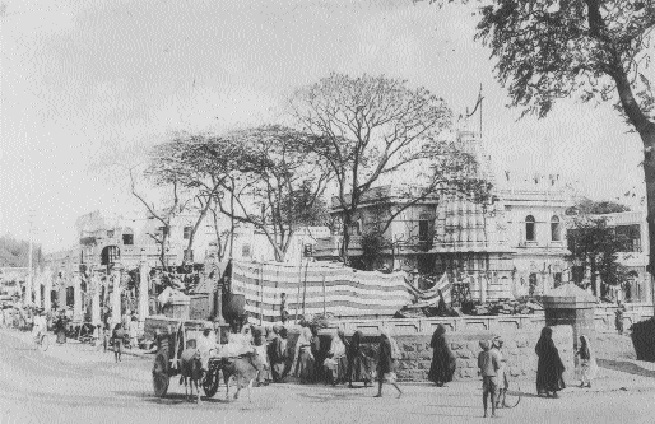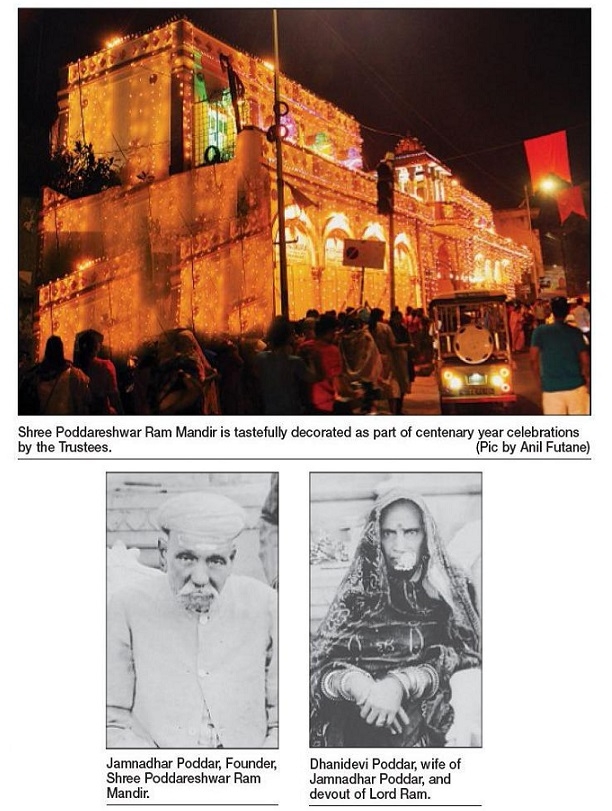Steeped in history, Shree Poddareshwar Ram Mandir celebrates its centenary
| Date :04-Mar-2023 |

Shree Poddareshwar Ram Mandir
By Sagar Mohod :
A CENTURY is a long journey! For an institution, it highlights the endurance power to achieve this milestone. Shree Poddareshwar Ram Mandir, a cultural heritage of Orange City, is basking in glory of devotion to Lord Ram, as it completes 100 years of its foundation on Saturday (March 4). The temple located on Central Avenue has stood testimony to times, some sad, some good, and yet it stayed intact, weathering all the seasons. The temple is managed by Poddar family of city, whose rise is intrinsically linked to Empress Mill which heralded industrial revolution in the country. Though Empress Mill faded away with time, Shree Poddareshwar Ram Mandir has sailed through, standing tall as a witness to growing stature of Nagpur, the second capital of Maharashtra. Start of Shree ‘Ram Navami Shobhayatra’ (this would be its 57th year) added to stature of the temple as over the years it is now intertwined into cultural landscape of the city. Ramkrishna Poddar, Managing Trustee, Shree Poddareshwar Ram Mandir, a Grade-II heritage, shared with ‘The Hitavada’ how it came into being.

“The temple came to be set up by our great grandfather Jamnadhar Poddar. He played a key role in establishing Empress Mill, erstwhile landmark of the city,” Poddar said. Jamnadhar lost his only son, Mohanlal, at a tender age of 16 years, wihch left a deep impact on him. He was very much disturbed by life’s uncertainties, even the vast fortune that Jamnadhar possessed could not help in saving his son. Unable to overcome the grief, Jamnadhar thought as to why not have something that would withstand time, something that would be immortal. This was the turning point that also heralded the magnificent structure, Shree Poddareshwar Ram Mandir. As to Jamnadhar’s arriving in city, Poddar said, the former’s name was referred to J N Tata by former’s cousin Nathuram Poddar as Tata was on lookout for a dynamic person to help with establishment of the first textile mill of the country. “Thus Jamnadhar came into the picture and that time he was in Indore and rest is then history,” said Poddar as he shared the family history as to how the former worked hard and laid the foundation of the country's industrial revolution. Pausing a bit, Poddar recalled, Jamnadhar’s wife, Dhanidevi used to worship Lord Ram while latter used to worship Lord Shiva. Dhanidevi used to visit Thadeshwar Ram Temple at Gandhisagar daily. Meanwhile, impressed by the hard work of Jamnadhar, J N Tata appointed him as sole agent to market the cloth produced at Empress Mill throughout the country, that time in undivided India.
“From thereon there was no looking back as Poddar family’s fortune rose phenomenally. Jamnadhar opened shops at Karachi, Rangoon and all leading cities of country. In- all, 52 shops were set up across length and breadth of the country,” Poddar recalled. That time the one share of Central India Spinning, Weaving and Manufacturing Company, the managing company of Empress Mill, with face value of Rs 100 used to be traded at Rs 1,600, indicating the premium it used to get. The untimely death of son Mohanlal shook Jamnadhar to the core and he moved towards spirituality and later adopted his grandson Amolakchand. After delving much, Jamnadhar went about scouting for place to construct a grand temple and set sight on land near Cotton Market, as it was adjacent to Nagpur Railway Station which was that time near Gandhisagar. Already he had set up a Dharmashala (Shree Jamnadhar Dharmashala) and naturally Jamnadhar decided to construct a temple here.
Jamnadhar contacted Jehangir Fardumji Parsi, who owned the land adjoining the Dharmashala, and the two gentlemen came to agreement and temple’s bhoomipujan was performed in year 1919, it was Shravan Pournima, and eve of Rakshabandhan. Incidentally, the complex houses both deities, one temple dedicated to Lord Ram and other one to Lord Shiva, symbolising the unique sangam. For construction of temple, the white marble was sourced from Sangmusa, Makrana in Rajasthan while red stone was brought from Koradi. The artisans came from Jaipur and temple was ready by year 1923. The main sculptor was Pt Govindram Udayram while Pt Bhagirathdas oversaw the construction. The entrance door at Lord Ram and Lord Shiva temple are crafted from silver and Ram Leela and Shiv Leela are inscribed respectively on them. The height of Shiv Temple is about 60 feet and top is crafted with marble stone. The main door to temple complex is prepared using brass and wood and is equally magnificent. The octagonal auditorium at the temple has eight pillars made from marble on which Ram Leela sketches are crafted and on top of it a thin lattice of marble provides an enchanting view.
To add to its grandeur the mix of white and black marble flooring. Similarly, showcasing the fine artistry, flowers and petals are inscribed in the sanctum, something that was common in Mughal era. The idols of Lord Ram, Sita and Laxman were brought by Jamnadhar Poddar by special rail coach and same were consecrated on February 28, 1923. Jamnadhar formed a Trust deed to oversee the temple affairs and managing committee that time included he himself, brother Jeevraj, nephew Nagarmal, grandson Amolakchand, Shivprasad Gadodiya, Gourishankar Goenkar and Mathuradas Rathi.
